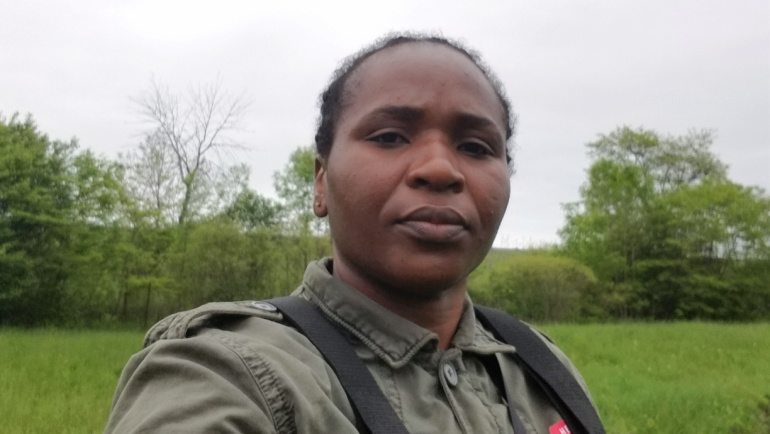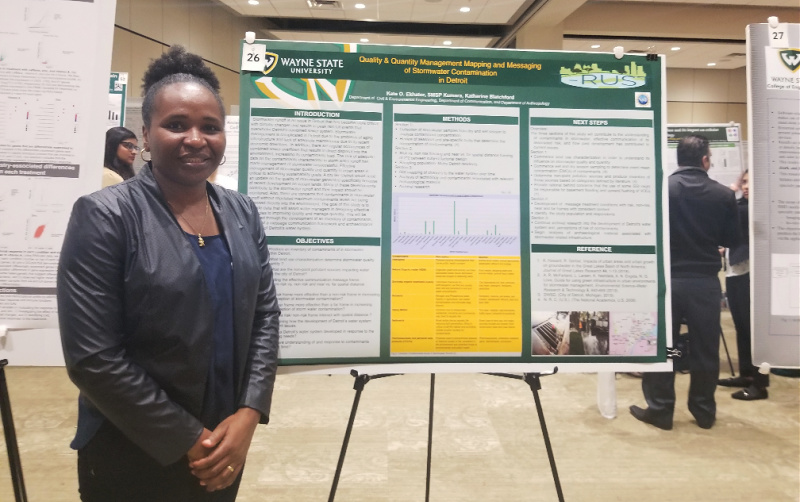
When Kate Ekhator looks at the trees, she not only sees a solution for Detroit’s stormwater problems, but also for issues in her home country of Nigeria. For the Wayne State University civil and environmental engineering Ph.D. student, the issue is personal.
“A lot of friends of mine have an issue with flooding. I felt my country was not doing anything about it,” said Ehkator, who came to study at Wayne State three years ago. “I lived in a building that flooded regularly. You could see the water was dirty and smelling of diesel or petrol. You didn’t know where it was coming from, you just knew this is contaminated.”
The irony was not lost on her. Back in Nigeria, Ekhator worked as a health, safety and environment officer at an oil and gas company for 15 years. She put together detailed, well-researched recommendations on how the company could improve its environmental impact. And almost every time, those recommendations fell on deaf ears.
“I saw so many things done to the environment. I felt, ‘Why?’” Ekhator said. “When you're in the industry for profit, even though you make recommendations, many times you can't force the management to implement them.”
She wanted a change, but also to make an impact.
In 2018, with a master’s in civil engineering from the University of Ibadan in Nigeria already under her belt, Ekhator made the decision to leave the industry and go back for her doctorate. But where? She preferred to stay in Nigeria. Her husband, who years earlier earned a master’s at Wayne State University in the Department of Civil and Environmental Engineering with a focus on transportation engineering, encouraged her to try applying abroad. “When I did, I reached out to the College of Engineering’s Carol Miller. That's how it all started, basically,” she said.
After being accepted, Ekhator explained her interest in water resources management to Miller, a professor in the Department of Civil and Environmental Engineering and director of Healthy Urban Waters. One of the first projects Ekhator worked on involved the inspection of homes that had basement flooding problems, a project conducted by Healthy Urban Waters.
Miller, in turn, got Ekhator involved in the Transformative Research in Urban Sustainability Training (T-RUST) program. T-RUST brings together graduate students from various disciplines to collaborate and solve urban sustainability issues.

“Some of the best people ever are at T-RUST. Donna Kashian, associate professor of biological sciences, is just wonderful,” Ekhator said. “I don't think I would have had that kind of exposure, if not for the program. And Dr. Miller is the main reason all of this continues to happen. She's still helping to make connections.”
Ekhator’s work with T-RUST also helped land an internship with the Greening of Detroit, a nonprofit that supports urban reforestation efforts, and set her current stormwater research in motion. There, she helped geocode the tree planting records.
“This was never my research focus, but I got that exposure to trees and urban tree canopy. I started looking at it, hearing a lot about it and I became really interested in this particular topic,” Ekhator said. “I have always been interested in sustainability — even before I knew what it really was — and how to solve problems sustainably, especially when it pertains to the environment.”
The work inspired Ekhator’s research — “The role of tree canopy in water quality improvement practices in urban areas” — which she presented at Wayne State’s annual Graduate Research Symposium. Her objectives included how tree canopy cover impacts stormwater management, ways to increase tree canopy cover in areas lacking it, and how the introduction of trees into stormwater control measures increase their retention capacity.
“There’s so much we can do with trees and we aren’t getting everything. I see there are a lot of area people still don't know much about. I feel I should be able to make a bit of contribution, and that has been my passion,” Ekhator said. “My daughter, jokingly, calls me a tree hugger now.”
Trees save nearly 400 billion gallons of stormwater annually by retaining a percentage of the precipitation through their leaf system, Ekhator noted in her presentation. In addition, the root structure also helps in holding another percentage of the precipitation. Furthermore, those same root structures create preferential pathways that increases infiltration capacity of soils. Some next steps include determining how tree canopy cover affect stream flow and quality.
“There are so many other cities that have the same water-quality issues. So, if it can work in a city like Detroit, then we should be able to make it work elsewhere,” Ekhator said. “We should always be looking for ways to reuse things, and not waste or degrade the environment. Because this is what we have — the Earth is not going to replenish itself.”
